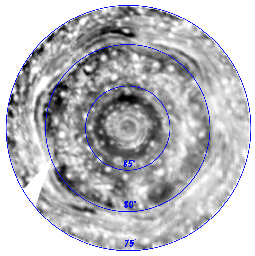
|
Infrared Movie of Saturn’s North Polar Region
- Click the image above for a larger view
 Movie Download Options
Movie Download Options- Full-Res JPEG (1034 x 1034) (130.6 kB)
- Full-Res TIFF (1034 x 1034) (1.1 MB)
Caption:
This near-infrared movie of Saturn's north pole shows a giant cyclone, encircled by a hexagon feature. The movie was created from several images, taken by the visual and infrared mapping spectrometer onboard the Cassini spacecraft.
The hexagon itself is populated by fast-moving clouds which reach speeds of over 530 kilometers per hour (300 miles per hour). The discrete, circular and oblong clouds dotting the image are likely convective upwelling originating deep inside the planet, which help power the cyclones. The movie shows clouds throughout the atmosphere, down to as deep as 125 kilometers (78 miles) below the haze. Many of the features seen are thought to be deep-level clouds of ammonia-hydrosulfide, which rise to higher altitudes in convective updrafts.
This movie is centered on the pole and shows the cyclonic motions of rings of clouds in the near-infrared wavelength of 5 microns, some seven times the reddest wavelength observed by the human eye. The resolution is better than 200 kilometers (124 miles) per pixel. The movie covers a six-hour period at close range (as close as 240,000 kilometers, or 149,000 miles above the clouds) from a nearly-overhead viewpoint. Winds reach over 150 meters per second (325 miles per hour) at 88.3 degrees south latitude, just outside the first bright ring nearest the pole.
Normally Saturn's internal glow illuminates Saturn's deep clouds from below, thus rendering the clouds in silhouette against this background glow. Nevertheless, for the movie, the contrast has been reversed to show the clouds as white, thus making the clouds appear more like they would if seen in reflected light.
This movie was created from four images obtained on June 15 over a range of distances between 224,000 and 422,000 kilometers (149,000 miles to 262,000 miles) above the clouds and a sub-spacecraft north latitude ranging from 69 to 78 degrees.
A polar orthographic projection was used, with 0 degrees longitude toward the top center, 90 degrees west longitude toward the right center, etc., based on the longitude system established by Voyager. Features are thus seen flowing in Saturn's reference frame, with the planet's spin eliminated.
Background Info:
The Cassini-Huygens mission is a cooperative project of NASA, the European Space Agency and the Italian Space Agency. The Jet Propulsion Laboratory, a division of the California Institute of Technology in Pasadena, manages the mission for NASA's Science Mission Directorate, Washington, D.C. The Cassini orbiter was designed, developed and assembled at JPL. The Visual and Infrared Mapping Spectrometer team is based at the University of Arizona.
For more information about the Cassini-Huygens mission visit http://saturn.jpl.nasa.gov/home/index.cfm . The visual and infrared mapping spectrometer team homepage is at http://wwwvims.lpl.arizona.edu .
Cataloging Keywords:
| Name | Value | Additional Values |
|---|---|---|
| Target | Saturn | |
| System | Saturn | |
| Target Type | Planet | |
| Mission | Cassini-Huygens | Voyager |
| Instrument Host | Cassini Orbiter | |
| Host Type | Orbiter | Flyby Spacecraft |
| Instrument | Visual and Infrared Mapping Spectrometer (VIMS) | |
| Detector | ||
| Extra Keywords | Ammonia, Atmosphere, Color, Haze, Infrared, Movie, Rotation | |
| Acquisition Date | ||
| Release Date | 2008-10-13 | |
| Date in Caption | ||
| Image Credit | NASA/JPL/University of Arizona | |
| Source | photojournal.jpl.nasa.gov/catalog/PIA11215 | |
| Identifier | PIA11215 | |
